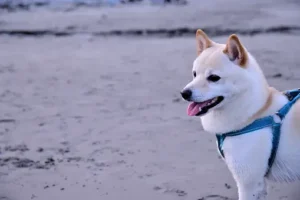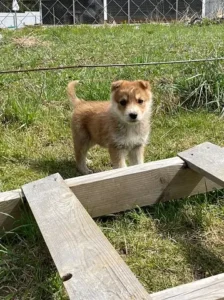The Ainu Dog, also known as the Hokkaido Dog, is a remarkable and ancient breed originating from the Hokkaido region of Japan. Renowned for its strength, resilience, and loyalty, the Ainu Dog has a rich history intertwined with the indigenous Ainu people, who revered and utilized these dogs for various purposes.
Physically, Ainu Dogs possess a sturdy and compact build, adapted to withstand the harsh climate of Hokkaido. Their thick double coat, erect ears, and curled tail provide insulation against the cold, making them well-suited for rugged terrains. These dogs are known for their intelligent and independent nature, often displaying a strong sense of guardianship and territorial instincts.
Traditionally employed as hunting and working dogs, Ainu Dogs are skilled in tasks such as tracking large game, pulling sleds, and protecting livestock. Their enduring loyalty to their human companions and adaptability to different roles have made them beloved family pets and working partners alike.
In recent times, the Ainu Dog’s population has faced challenges due to urbanization and modernization. However, dedicated efforts by breed enthusiasts and conservationists have helped preserve and promote this cultural and historical treasure. With its deep-rooted connection to Japan’s heritage and its versatile abilities, the Ainu Dog continues to captivate hearts as a faithful companion and a living link to the past.
1. Historical Origins and Cultural Significance

The Ainu Dog, an ancient and distinct breed, boasts a rich historical lineage intertwined with the indigenous Ainu people of Japan. Revered for their loyalty, resilience, and versatile skills, these dogs played an integral role in Ainu culture. Originating in Hokkaido, the Ainu’s northernmost island, these canines were more than mere companions; they were guardians, hunters, and spiritual symbols.
Bearing a striking resemblance to the Hokkaido wolf, Ainu Dogs were revered as sacred protectors and revered hunting aides. Their close bond with the Ainu people is evident in folklore, where they were often depicted as loyal guardians of the home and family. These dogs were crucial for survival, aiding in hunting large game and providing warmth during frigid winters.
Culturally significant ceremonies, such as the Iomante ritual, further exemplify the Ainu Dog’s importance. In these rituals, dogs were symbols of the journey between life and death, reflecting the Ainu belief in an interconnected world.
However, modernization and societal changes have led to a decline in both Ainu culture and the population of Ainu Dogs. Today, dedicated efforts are being made to preserve this breed and its historical ties to the Ainu people, honoring their shared heritage and recognizing the vital role these dogs played in shaping Ainu society.
2. Physical Characteristics and Appearance
The Ainu Dog, also known as the Hokkaido Dog or Ainu Innu, boasts a striking and robust physical appearance that reflects its resilience and adaptability to its native environment. These medium-sized dogs exhibit a well-balanced and muscular build, standing around 18 to 22 inches (45 to 55 cm) at the shoulder and weighing between 45 to 65 pounds (20 to 30 kg). Their distinct double coat provides protection against harsh weather conditions, with a dense, straight outer coat that repels moisture and a soft undercoat that offers insulation.
Characterized by a range of coat colors, including red, brindle, sesame, white, and black and tan, Ainu Dogs present a versatile and eye-catching array of patterns. Their upright, triangular ears and plumed tail, often carried curled over the back, contribute to their captivating appearance. A keen and intelligent expression in their almond-shaped eyes reflects their alert nature and strong connection to their surroundings.
This breed’s physical attributes are a testament to its evolution as a capable and enduring working dog. While modern variations may exhibit slight deviations from traditional standards due to selective breeding, the overall essence of the Ainu Dog’s appearance remains a homage to its historical and cultural roots within the Ainu people’s way of life.
3. Ainu Dog’s Unique Traits and Abilities

The Ainu Dog, a cherished breed originating from Japan’s Ainu region, possesses a remarkable array of unique traits and abilities. Renowned for their exceptional loyalty and unwavering dedication, these dogs have historically played vital roles within Ainu society.
Physically distinct, Ainu Dogs exhibit a plush double coat that safeguards them against the harsh climates of Hokkaido, the Ainu homeland. This coat, marked by a thick undercoat and longer guard hairs, provides both insulation and protection. Their distinctive curled tail, a symbol of their breed, adds to their recognizable appearance.
Beyond their physical attributes, Ainu Dogs boast an acute sense of awareness and attentiveness, enabling them to excel as watchdogs and protectors. Their keen instincts have been honed through generations of coexisting with Ainu people, serving as companions and guardians. This heightened awareness makes them adept at detecting potential threats and strangers, cementing their role as a sentinel in Ainu households.
Moreover, their gentle disposition towards family members and children further accentuates their uniqueness. While vigilant and cautious around unfamiliar individuals, Ainu Dogs demonstrate a deep bond with their human companions, reflecting their role as trusted allies in the Ainu way of life.
In modern times, efforts are being made to preserve the Ainu Dog’s distinct characteristics and preserve its connection to Ainu culture, ensuring that this remarkable breed’s traits.
How Smart Are Corgis? 7 Useful Points We Know About Their Intelligence
4. Role of Ainu Dogs in Traditional Ainu Society
In traditional Ainu society, Ainu dogs played a multifaceted and integral role. Renowned for their intelligence, loyalty, and versatility, these dogs were essential companions and collaborators in various aspects of Ainu life. As skilled hunters, Ainu dogs assisted in tracking and capturing game, contributing to the community’s sustenance. Their acute senses were harnessed in activities like bear hunting, alerting Ainu hunters to the presence of these formidable creatures.
Beyond hunting, Ainu dogs had cultural significance, serving as guardians of Ainu households and camps. Their watchful nature made them effective protectors, alerting the community to potential threats from both wildlife and other groups. Moreover, Ainu dogs fostered a strong sense of companionship, often becoming cherished members of Ainu families. Their presence in daily life and rituals showcased the close bond between humans and animals in Ainu culture.
Ainu dogs also held spiritual importance, being believed to possess the ability to communicate with the spirit world. This belief added a layer of mystique to their role, elevating them beyond mere animals and connecting them to the spiritual fabric of Ainu beliefs.
In essence, Ainu dogs were more than mere tools for survival; they embodied the symbiotic relationship between the Ainu people and the natural world. Their contributions as hunters, protectors, and spiritual intermediaries shaped the intricate tapestry of traditional Ainu society.
5. Modern Preservation Efforts and Recognition

In recent years, concerted efforts have emerged to preserve and recognize the Ainu Dog as an integral part of cultural heritage. These initiatives aim to safeguard the breed’s unique genetic lineage and historical significance. Various organizations, both within and outside the Ainu community, have collaborated to raise awareness about the breed’s endangered status and promote responsible breeding practices.
Recognizing the Ainu Dog’s role as a symbol of Ainu identity, local and international organizations have worked together to attain official recognition and protection for the breed. Advocacy for the Ainu Dog’s inclusion in breed registries and conservation programs has gained momentum, bolstered by its distinct characteristics and historical importance.
Additionally, the growing interest in indigenous cultures and their traditional practices has led to increased attention on the Ainu people and their canine companions. Documentaries, exhibitions, and educational initiatives have contributed to a broader understanding of the Ainu Dog’s role in the past and present.
While challenges remain, the modern efforts dedicated to the preservation and recognition of the Ainu Dog underscore the importance of protecting cultural heritage and maintaining a vital link to the Ainu people’s history and way of life.
6. Ainu Dog’s Temperament and Behavior
The Ainu Dog is characterized by a loyal and gentle temperament, making it a cherished companion. Known for its strong bond with its human family, this breed exhibits a calm and patient demeanor, making it well-suited for domestic life. The Ainu Dog is naturally protective, often displaying a watchful and alert attitude, making it an effective guardian.
While reserved with strangers, it forms deep attachments to its family members, showing affection and loyalty. This breed’s history as a hunter and protector is reflected in its independent and intelligent nature. Ainu Dogs are known to be adaptable and can thrive in various environments, although they may require early socialization and training to manage their sometimes aloof behavior. Overall, the Ainu Dog’s blend of loyalty, protectiveness, and adaptability makes it a unique and valued companion with a special place in both its native Ainu culture and modern households.
7. Training and Care for Ainu Dogs
Training and caring for Ainu Dogs requires attention to their unique heritage and characteristics. Begin socialization early to ensure a well-adjusted companion. Due to their loyal nature, positive reinforcement techniques work best during training. Daily exercise is essential to maintain their agility and energy levels. Regular grooming, including brushing their thick double coat, prevents matting and promotes a healthy coat. Monitor their health closely, addressing potential breed-specific concerns such as hip dysplasia. Adequate mental stimulation, combined with a loving and structured environment, ensures a happy and well-behaved Ainu Dog.
8. Comparing Ainu Dogs to Other Breeds

Ainu Dogs, a treasured breed originating from Japan’s Ainu people, possess distinct qualities that set them apart from other breeds. Their elegant appearance, characterized by a plush double coat and curled tail, distinguishes them from most canines. In contrast to the Ainu Dog’s reserved and dignified demeanor, breeds like the Labrador Retriever exude exuberance and playfulness.
Ainu Dogs’ unique connection with their human companions, deeply rooted in Ainu culture, contrasts with the independent nature of breeds like the Basenji. Unlike the highly trainable German Shepherd, Ainu Dogs exhibit a more independent streak, reflecting their historical role as guardians rather than working dogs.
The breed’s genetic isolation among the Ainu people has contributed to its remarkable purity, setting it apart from the diverse lineages of breeds like the Border Collie. Though sharing some physical similarities with the Shiba Innu, Ainu Dogs possess a distinctive temperament shaped by their ancestral bond with the Ainu community.
In comparing Ainu Dogs to other breeds, it becomes evident that their unique blend of physical traits, temperament, and historical significance make them a truly one-of-a-kind canine companion, offering a glimpse into both the rich heritage of the Ainu people and the fascinating diversity of the dog kingdom.
30 Amazing Facts About Deer And Types
9. Ainu Dog: An Endangered Heritage
These dogs, a cherished cultural heritage of the Ainu people, faces the threat of extinction. With deep historical roots, these dogs have been an integral part of Ainu society for centuries. Revered for their loyalty, intelligence, and versatility, Ainu Dogs historically served as hunting partners, guardians, and companions.
However, modernization, societal shifts, and dwindling interest in traditional practices have placed the Ainu Dog at risk. The breed’s population has sharply declined, and its genetic diversity is shrinking, posing significant challenges to its survival. Efforts to preserve this endangered heritage involve collaboration between Ainu communities, breed enthusiasts, and conservationists.
To safeguard the Ainu Dog, urgent measures are required. Raising awareness about their cultural significance, promoting responsible breeding, and supporting local initiatives can help prevent the fading of this remarkable breed. Preserving the Ainu Dog extends beyond safeguarding a species—it embodies the preservation of Ainu identity, traditions, and a profound connection to the past.
10. Ainu Dog’s Adoption and Popularity Beyond Ainu Culture

The Ainu Dog, a breed historically intertwined with the Ainu people of Japan, is gradually gaining recognition and adoption beyond its traditional cultural context. Renowned for their loyalty, intelligence, and strong bonds with humans, Ainu Dogs are captivating the hearts of dog enthusiasts worldwide.
As cultural appreciation and curiosity expand, more individuals and families are welcoming Ainu Dogs into their homes. Their distinctive appearance and deep-rooted history serve as an intriguing attraction. Despite originating as working companions and guardians for the Ainu people, these dogs are finding new roles as beloved family pets and companions.
In recent years, efforts to preserve and promote the Ainu Dog breed have led to heightened awareness. Breed enthusiasts, breeders, and organizations are collaborating to ensure the genetic diversity and well-being of these dogs. The Ainu Dog’s unique blend of heritage and qualities, including their adaptability and gentle nature, contribute to their growing popularity among a broader audience.
While their presence beyond Ainu culture is relatively nascent, the Ainu Dog’s adoption signals a promising future for this remarkable breed. As people discover and appreciate the cultural and historical significance of these dogs, their popularity is set to expand, fostering a deeper connection between diverse communities and the legacy of the Ainu Dog.
11. Health Considerations and Breed Preservation Challenges
The Ainu Dog, a treasured breed with deep historical roots, faces several health considerations and breed preservation challenges. Due to its limited gene pool and historical isolation, the Ainu Dog is prone to inheritable health issues, including hip dysplasia and certain genetic disorders. These health concerns underscore the importance of responsible breeding practices and genetic screening to maintain the breed’s vitality.
Breed preservation presents its own set of challenges. With a dwindling population and the encroachment of modernization, the Ainu Dog’s traditional role has evolved, affecting its numbers and cultural relevance. Ensuring the survival of the Ainu Dog requires a delicate balance between retaining its unique traits and adapting to contemporary environments. Collaborative efforts among breed enthusiasts, researchers, and cultural advocates are essential for safeguarding the Ainu Dog’s legacy for future generations.
12. Ainu Dog in Art, Literature, and Pop Culture
The Ainu Dog holds a captivating presence in art, literature, and pop culture, serving as a symbol of cultural heritage and loyalty. Artists and writers have been inspired by the breed’s unique appearance and historical significance. In Japanese literature, Ainu Dogs often represent companionship and fidelity, showcased in poems and stories that highlight their unwavering loyalty to humans. These dogs have also made appearances in contemporary literature, adding a touch of tradition to modern narratives.
The Ainu Dog’s distinctive appearance has caught the attention of artists across mediums. Paintings, sculptures, and illustrations often feature these dogs, showcasing their majestic and dignified demeanor. In pop culture, Ainu Dogs have found their way into movies, TV shows, and advertisements, emphasizing their role as cherished companions.
Moreover, the Ainu Dog’s presence extends to cultural festivals and events, where their historical significance is celebrated. These dogs have become ambassadors for Ainu culture, drawing attention to the traditions and heritage of the Ainu people. As the breed’s population faces challenges, efforts to preserve their legacy have gained momentum, further cementing the Ainu Dog’s place in art, literature, and contemporary culture.
13. Stories and Anecdotes Featuring Ainu Dogs
Ainu Dogs, cherished companions of the Ainu people, have woven their loyalty and bravery into the fabric of Ainu culture. One notable tale recounts an Ainu Dog named “Hakkoda-maru,” whose unwavering dedication saved his owner from peril. In the depths of a frigid winter, Hakkoda-maru guided his owner through a blinding snowstorm, using his keen senses to navigate treacherous terrain. When they became trapped by an avalanche, Hakkoda-maru’s barks alerted rescuers to their location, ultimately saving both lives.
Another heartwarming anecdote celebrates the bond between Ainu children and their canine friends. In a remote village, a young girl named Saki formed an unbreakable connection with her Ainu Dog, “Yuki.” Together, they would explore the forests, sharing secrets and finding solace in each other’s company. As Saki grew older, Yuki remained a steadfast companion, offering comfort during times of sorrow and joy during moments of triumph.
These stories exemplify the profound role these dogs played in the lives of the Ainu people, transcending their status as mere pets to become valued members of the family. Through tales of courage, loyalty, and friendship, these dogs continue to inspire reverence and respect within Ainu culture and beyond.
14. Exploring the Connection Between Ainu People and Their Dogs
The connection between Ainu people and their dogs is a profound and integral aspect of Ainu culture. For centuries, these dogs have been more than just companions; they’ve been valued members of households, playing essential roles in daily life. These dogs, known for their loyalty, intelligence, and adaptability, have forged a deep bond with the Ainu people.
In Ainu society, dogs were not merely pets but served as versatile partners. They assisted in hunting, guarding, and herding, showcasing their utility in both practical and spiritual contexts. These dogs were considered spiritual beings, believed to possess divine qualities and a strong connection to the natural world.
This unique connection is reflected in Ainu folklore, where dogs are revered for their role as intermediaries between humans and the spiritual realm. Rituals and ceremonies often included the participation of dogs, symbolizing their significance in bridging the gap between the physical and metaphysical.
As Ainu culture faces modern challenges and changes, efforts are being made to preserve and celebrate the deep-rooted relationship between Ainu people and their dogs. Initiatives to protect and promote this heritage ensure that the profound connection and cultural significance of these dogs continue to be passed down through generations, keeping alive a testament to the enduring bond between humans and their loyal companions.
FAQ’s:
What is an Ainu Dog and what makes it unique?
These Dog, also known as “Ainu Innu” or “Ainu Ken,” is a traditional Japanese breed originating from the Ainu people of Hokkaido. These dogs are known for their remarkable loyalty, intelligence, and adaptability. They have a distinctive appearance with a curled tail, erect ears, and a thick double coat, which helped them thrive in Hokkaido’s cold climate. These Dogs have a deep historical and cultural connection with the Ainu people, serving as hunting partners, guardians, and spiritual companions.
What role did Ainu Dogs play in Ainu society?
These Dogs had multifaceted roles in Ainu society. They were essential partners in hunting expeditions, assisting in tracking game such as bears and boars. These dogs were also skilled at herding and guarding livestock. Beyond their practical roles, these Dogs held a spiritual significance and were believed to possess divine qualities, acting as mediators between the human and spiritual realms in Ainu rituals and ceremonies.
Are Ainu Dogs still present today, and are they endangered?
While these dogs have faced a decline in numbers over the years, efforts have been made to preserve the breed and its cultural importance. They are recognized as a national monument in Japan, and various conservation initiatives aim to safeguard their genetic diversity and cultural heritage. However, Ainu Dogs are still considered rare, and ongoing conservation work is crucial to ensure their continued existence.
What is the temperament of Ainu Dogs, and are they suitable as pets?
These dogs are known for their loyalty, affection towards their family, and cautious nature around strangers. They can be independent and require consistent training and socialization from an early age. While their strong guarding instincts make them excellent protectors, potential owners should be prepared to invest time in training and providing mental stimulation. Ainu Dogs can make wonderful companions for dedicated and experienced dog owners who appreciate their unique traits.
How can I learn more about Ainu Dogs and contribute to their preservation?
To learn more about these dogs, you can explore resources such as books, documentaries, and online articles that focus on their history, characteristics, and cultural significance. Supporting organizations dedicated to these dog conservation, such as breed clubs and cultural heritage groups, is an excellent way to contribute to their preservation. Donations, volunteer work, and spreading awareness can all play a role in ensuring the these dog’s legacy continues to thrive.


